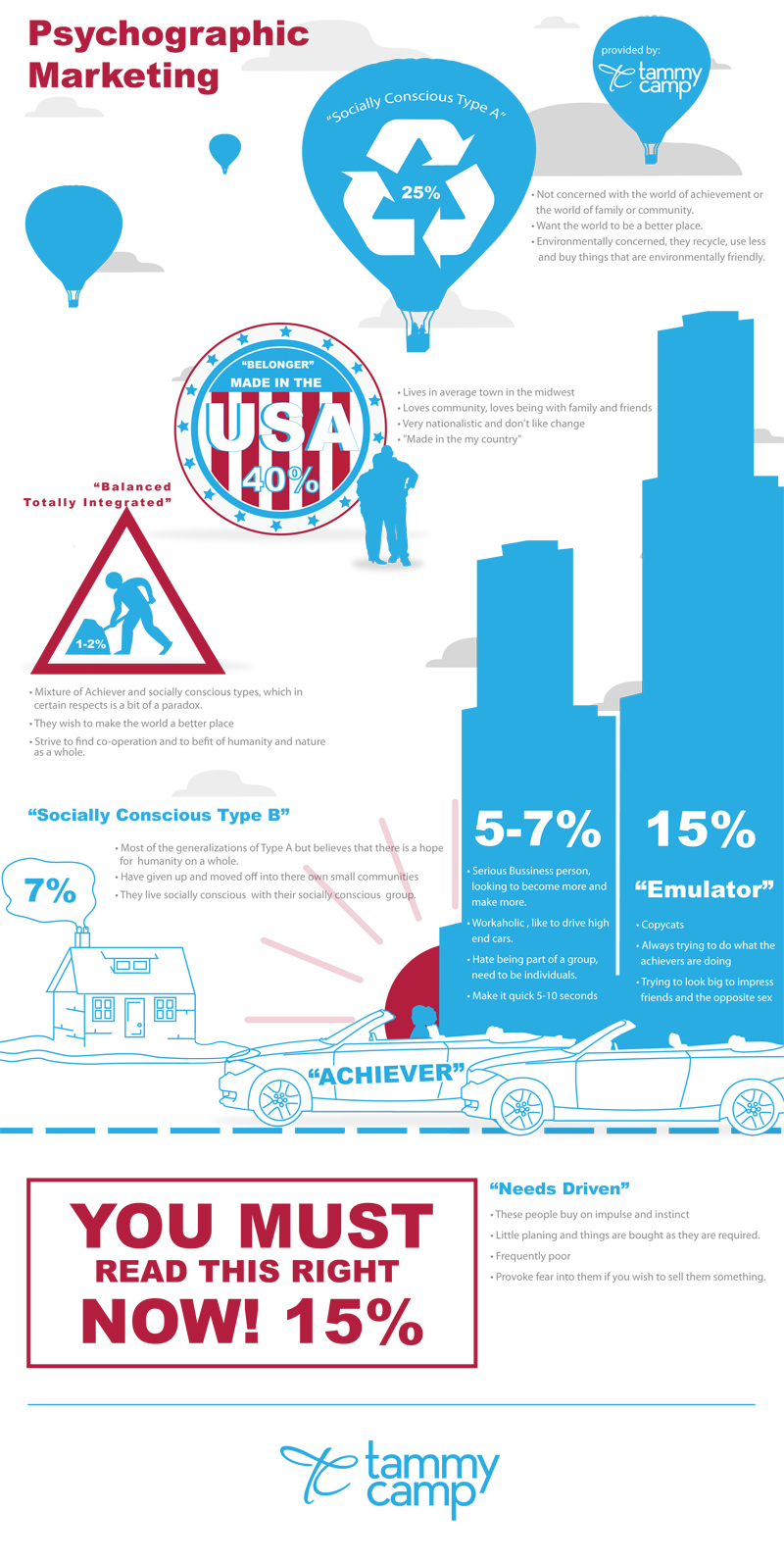Psychographic Marketing Strategy

Psycho-what?
Wikipedia defines psychographics as “Psychographics is the study of personality, values, opinions, attitudes, interests, and lifestyles. Because this area of research focuses on interests, attitudes, and opinions, psychographic factors are also called IAO variables.“
Understanding your customers on an emotional level is one of the keys to building the types of lasting relationships that ensure your business success. Understanding things like the way your customers think, what they value, what they struggle with, and what comes easily to them are all critical parts of figuring out what makes them tick. And, when you understand how and when your prospects make buying decisions, you’re halfway towards converting them to customers.
Marketing is all about positioning your products and services so that they are in front of the right people at the right time in the buying process. It’s about charting your prospects’ journey, starting at the point before they even know they need something like what you have to offer. The journey ends when those prospects decide to buy. You want to make sure those prospects become YOUR customers, not your competitors’. And, you want to make sure that the journey doesn’t end there. It continues along as you build deeper relationships and a loyal base of customers.
Sound like a huge task to undertake? It’s certainly not a quick and easy one, but it’s the foundation of any good marketing plan. And don’t worry. There is far more information out there than you can imagine that will help you chart the buying journey and understand your customers. There are analytics tools for determining how people are finding your site, what they’re doing once they get there, and how long they stay. You can also learn a bit about your audience based on some key demographics like geographic region.
All the information you gather will help you create a profile of your “ideal customer.” This is the person who perfectly fits your business model. It’s the customer who buys from you consistently, is good to work with, and stays loyal for many years.
Of course, you can have many different ideal customers. For example, a business coach may work with both solo entrepreneurs and small businesses. A plumbing business might attract both home owners and building contractors. A foreign language tutor might be looking to work with both college students prepping for exams and larger businesses needing to prep for an extended assignment abroad. Each group has their own unique needs and goals. Content marketing tactics need to be created for each audience.
So how do you determine your ideal customer and your target audience?
There are three key segments that marketers typically look at to define their target audience. They are:
1. Demographic
2. Geographic
3. Psychographic
Let’s take a brief look at all three segments. However, we’ll spend the bulk of the time focusing on the last one – Psychographic. That’s the hardest one to pin down, and yet it’s the one that will have the biggest impact on how you make your marketing decisions.
Some of the information in this report might seem complicated at first, since it’s not a topic covered in much depth in introductions to marketing. But stick with it and take your time. It’s all worth in the end if the information helps you grow your business to a whole new level.
Let’s start by taking a broad look at the 3 audience profile segments independently and give examples of what they represent and why they’re important.
3 Graphic Segments That Make Up Your Target Audience
Your audience is a targeted group. They have unique characteristics that make them who they are. Those unique characteristics in many cases can be quantified. This quantification or the ability to measure and track them makes it much easier to market to them.
Let’s look at Demographics first because that’s the segment that you’re probably most familiar with.
Demographic
Demographics are the statistical data that represent your audience. This information helps you determine who is buying your products or services. This data helps you narrow down who you’re marketing to. Here are some examples of demographics:
- The age of your audience. For example, age 30-55
- The gender of your audience. For example, women
- The income of your audience. For example, an annual income of $50,000 to $75,000
- Their education. For example, has achieved a bachelor’s degree or higher
Demographic data is generally the data that you can find on a census. It’s measurable, quantifiable, and it essentially tells you who is buying your products or services.
For example, it’s much more helpful to know that you’re marketing to women age 35-55 that have a bachelor’s degree or to men age 18-25 who don’t. The marketing tactics you use and the content you publish will be dramatically different for those two demographic groups.
Demographic information plays an important role in both determining and understanding your target audience. Geographic information is also quite essential. Let’s take a look at that segment of your audience next.
Geographic
Geographic information tells you where your audience is buying. This information can be quite significant. For example, there may be a big difference between women from the southern United States versus women from the East Coast. And the differences are even more significant when you start talking about audiences from different countries.
Even cities within the same state have different personalities and needs. For example, Dallas, Texas has a very different population than Austin, Texas. In addition to ideologies, the lifestyle and demographics of those two cities are quite different. So it’s helpful to know where your target audience resides.
Marketing content for geographic regions can vary. Think about the different cultures and holidays for countries around the world. It’s good to know where your target audience lives so you can create unique marketing content for them.
For example, a Thanksgiving holiday promotion for a Canadian audience would be different than one in the States, both in terms of message and timing.
Segmentation can add power to your marketing and increase your return on investment. And, while both demographic and geographic information can help you take your marketing to a whole new level and gain a better understanding of your audience, it’s not complete information. You need to also look at psychographics.
Psychographic of Your Target Audience in Online Marketing
Put simply, psychographic information determines why your audience is buying your products or services. Your audience’s psychographic information is comprised of many variables. Some of these variables can be difficult to pin down.
As mentioned before, this report is dedicated to showing you how to determine your audience’s psychographic information. We’ll look at how to use the information you gather, how to track and measure it, and how to start incorporating that information into your marketing plans.
Let’s first take a brief look at some of the variables of psychographics.
Psychographics are the traits that make your audience unique. These include things like:
Lifestyle
Where is your audience in terms of their life and how do they live it? For example, are they struggling or are they highly successful? Do they enjoy nature, music or fine arts?
Values
What does your audience value? Are they motivated by thoughts of their family? Does earning more money drive them? Are they liberal or conservative?
Social Class
What is your audience’s economic status and social class? For example, a young adult may be struggling financially but be in a higher social class because of their upbringing and their college education.
Other elements can include opinions, purchasing motives, personality and interests. As you can see, it can be difficult to gain this type of information about your audience. But once you have it, it can be tremendously powerful. You’re able to craft content and plan marketing initiatives that speak directly to your audience and have a much stronger conversion rate and return on investment.
Here is an simple and interesting illustration of Psychographic Marketing by entrepreneur and venture investor Tammy Camp. 
Over and over again, I see client’s putting in huge efforts at blogging, social media, visual marketing, etc without ever finding out the psychographics of their market which would make such a difference – the difference between running on a treadmill versus finishing the marathon at the head of the pack. Spend some time determining your audience’s psychgraphics and it will be time well spent.
When you understand how and when your prospects make buying decisions, you’re halfway towards converting them to customers. This 32 page ebook and accompanying worksheets will take you from Determining Who is Buying your Products or Services right through to Putting It All Together.


0 Comments
Trackbacks/Pingbacks